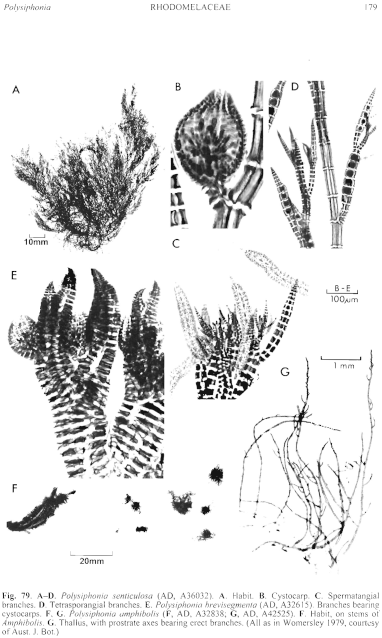|
|
|
|
|
|||||||||||
|
Electronic Flora of South Australia Species Fact Sheet
Phylum Rhodophyta – Family Rhodomelaceae – Tribe Polysiphonieae
Selected citations: Millar & Kraft 1993: 57. Shepherd & Womersley 1981: 367.
Thallus (Fig. 79E) dark red-brown, 3–5 mm high, occurring as small erect tufts. Attachment by a basal tuft of rhizoids; epiphytic on Codium capitulatum. Structure. Rhizoids relatively coarse, simple or occasionally branched, cut off from pericentral cells near the base of erect axes which are subdichotomously branched several times. Lower axes 400–550 µm in diameter, tapering slightly until close to apices, then decreasing more abruptly from 150–200 µm in diameter to the pointed apices; segments L/D throughout thallus about 0.2, with all mature pericentral cells laterally elongate (Fig. 79E); laterals arising close to apices, apparently replacing trichoblasts, with occasional laterals from near the base. Pericentral cells 4, ecorticate throughout most of thallus but with slight cortication near the base of the erect axes; trichoblasts and scar cells on every segment, with a divergence of 1/4; trichoblasts slender, several times furcate, scar cells prominent, elongate radially to thallus. Rhodoplasts discoid, scattered.
Reproduction: Gametophytes dioecious. Carposporophytes with a small basal fusion cell and short gonimoblast with clavate carposporangia 30–40 µm in diameter. Cystocarps (Fig. 79E) subsessile, ovoid, 300–500 µm in diameter; pericarp ostiolate, 2 cells thick, outer cells isodiametric, angular. Spermatangial branches replacing whole trichoblast, 150–300 µm long and 100–200 µm in diameter, with a single dome shaped, sterile apical cell.
Tetrasporangia unknown.
Type from Elliston, S. Aust., on Codium capitulatum in shaded areas within south point of bay, about low tide level (Gordon, 16.v.1968); holotype in AD, A32615.
Distribution: Only known from the type, and reported from Lord Howe I. (Millar & Kraft 1993, p. 57).
Taxonomic notes: Although still only known in southern Australia from the single type collection of a few sexual plants, P. brevisegmenta appears to be a distinctive though diminutive species. It is, however, very similar in most characteristics to P. forfex, differing in having only 4 pericentral cells compared with 6 in the latter. The closest species with 4 pericentral cells in southern Australia is P. succulenta Harvey, which differs in size, filament dimensions, and in having both segments and pericentral cells distinctly longer than in P. brevisegmenta.
References:
MILLAR, A.J.K. & KRAFT, G.T. (1993). Catalogue of marine and freshwater Red Algae (Rhodophyta) of New South Wales, including Lord Howe Island, South-western Pacific. Aust. Syst. Bot. 6, 1–90.
SHEPHERD, S.A. & WOMERSLEY, H.B.S. (1981). The algal and seagrass ecology of Waterloo Bay, South Australia. Aquat. Bot. 11, 305–371.
WOMERSLEY, H.B.S. (1979). Southern Australian species of Polysiphonia Greville (Rhodophyta). Aust. J. Bot. 27, 459–528.
The Marine Benthic Flora of Southern Australia Part IIID complete list of references.
Publication:
Womersley, H.B.S. (24 February, 2003)
The Marine Benthic Flora of Southern Australia
Rhodophyta. Part IIID. Ceramiales – Delesseriaceae, Sarcomeniaceae, Rhodomelaceae
Reproduced with permission from The Marine Benthic Flora of Southern Australia Part IIID 2003, by H.B.S. Womersley. Australian Biological Resources Study, Canberra. Copyright Commonwealth of Australia.
Illustration in Womersley Part IIIA, 2003: FIG. 79E.

Figure 79 enlarge
Fig. 79. A–D. Polysiphonia senticulosa (AD, A36032). A. Habit. B. Cystocarp. C. Spermatangial branches. D. Tetrasporangial branches. E. Polysiphonia brevisegmenta (AD, A32615). Branches bearing cystocarps. F, G. Polysiphonia amphibolis (F, AD, A32838; G, AD, A42525). F. Habit, on stems of Amphibolis. G. Thallus, with prostrate axes bearing erect branches. (All as in Womersley 1979, courtesy of Aust. J. Bot.)

|
Email Contact: State Herbarium of South Australia |

|